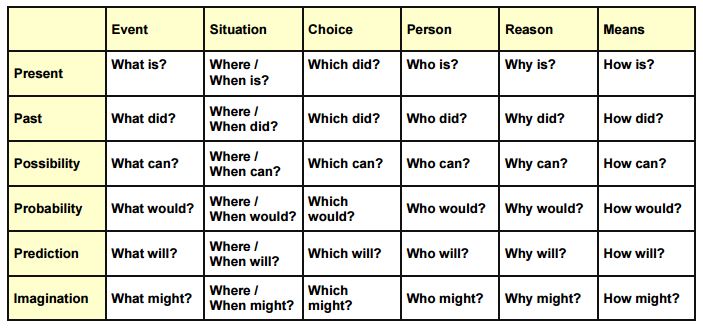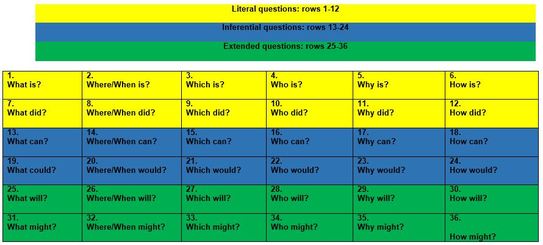The Q-Matrix
Question starters for higher order thinking
Thinking skills can be taught. This helps learners to become more aware of their own learning, and develop more responsibility which will give them the thinking skills to become life-long learners.
The Question Matrix was developed by Chuck Weiderhold, it is a set of question starters designed to develop higher-order thinking. (Wiederhold & Kagan, 1998.)
The Question Matrix was developed by Chuck Weiderhold, it is a set of question starters designed to develop higher-order thinking. (Wiederhold & Kagan, 1998.)
Retrieved July 2015 from: http://www.decd.sa.gov.au/assessment/files/pages/strategies/Question_Matrix.pdf
Thinking about thinking
The Q-Matrix can be used alongside Gardner's Multiple Intelligence Theory when getting students to think metacognitively about the kinds of thinking they are doing.
Use the question starters to come up with questions for your students that will get them reflecting on the types of thinking they are using.
Here are some examples:
How would you use your number smart thinking to figure this out?
When might you use your nature smart thinking?
Why is it easier for you to learn by doing things?
When did you last use your people smart thinking?
What would it look like?
What would it sound like?
Who is a famous/successful person who uses their body smart a lot?
How will I improve my number smart skills?
Which kind of smart might artists use a lot of?
Use the question starters to come up with questions for your students that will get them reflecting on the types of thinking they are using.
Here are some examples:
How would you use your number smart thinking to figure this out?
When might you use your nature smart thinking?
Why is it easier for you to learn by doing things?
When did you last use your people smart thinking?
What would it look like?
What would it sound like?
Who is a famous/successful person who uses their body smart a lot?
How will I improve my number smart skills?
Which kind of smart might artists use a lot of?
why use a question matrix?
|
The Question Matrix is designed for the students to think and act critically about information they are processing. Differing questions are set including who, what, when, where, why and how are asked, but with different endings to emphasise the question.
|
|
|


